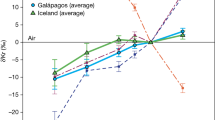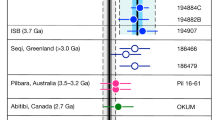Abstract
Determining the presence of solar argon, krypton and xenon in the Earth's mantle is important for understanding the source, incorporation mechanism and transport of noble gases in the Earth, as well as the evolutionary history of the Earth's atmosphere. There are strong indications in the mid-ocean ridge basalt database that solar helium and neon are indeed present1,2,3, and modelling exercises indicate that the compositions of all five noble gases in the Earth's primordial inventory were solar-like3,4,5. But solar isotopic signatures of the heavier noble gases argon and xenon, which differ significantly from atmospheric compositions, have appeared only subtly if at all in analyses of mantle-derived samples6 — their non-radiogenic isotope ratios are generally found to be indistinguishable or only slightly different from those in the atmosphere2,7,8,9,10. The first promising isotopic evidence for a solar-like argon component in the Earth's mantle appeared in a recent analysis of basalt glasses from the Hawaiian Loihi seamount11. Here I show that recent measurements12 of neon and argon isotopes in a suite of mid-ocean ridge basalt samples from the southern East Pacific Rise greatly strengthen the case for the presence of solar argon, and by inference krypton and xenon, in the Earth's mantle.
This is a preview of subscription content, access via your institution
Access options
Subscribe to this journal
Receive 51 print issues and online access
$199.00 per year
only $3.90 per issue
Buy this article
- Purchase on Springer Link
- Instant access to full article PDF
Prices may be subject to local taxes which are calculated during checkout


Similar content being viewed by others
References
Honda, M., McDougall, I., Patterson, D. B., Doulgeris, A. & Clague, D. A. Asolar component in the Earth: Neon isotope anomalies in Loihi and Kilauea basalts. Nature 349, 149–151 (1991).
Honda, M., McDougall, I., Patterson, D. B., Doulgeris, A. & Clague, D. A. Noble gases in submarine pillow basalt glasses from Loihi and Kilauea, Hawaii: A solar component in the Earth. Geochim. Cosmochim. Acta 57, 859–874 (1993).
Farley, K. A. & Poreda, R. J. Mantle neon and atmospheric contamination. Earth Planet. Sci. Lett. 114, 325–339 (1993).
Pepin, R. O. On the origin and early evolution of terrestrial planet atmospheres and meteoritic volatiles. Icarus 92, 2–79 (1991).
Pepin, R. O. Evolution of Earth's noble gases: Consequences of assuming hydrodynamic loss driven by giant impact. Icarus 126, 148–156 (1997).
Pepin, R. O. Are isotopically solar components present in heavy noble gases from terrestrial mantle samples? Perhaps … Lunar Planet. Sci. XXVI, 1109–1110 (Lunar & Planetary Institute, Houston,(1995)).
Ozima, M. & Zashu, S. Noble gas state of the ancient mantle as deduced from noble gases in coated diamonds. Earth Planet. Sci. Lett. 105, 13–27 (1991).
Ozima, M. Noble gas state in the mantle. Rev. Geophys. 32 (4), 405–426 (1994).
Hiyagon, H., Ozima, M., Marty, B., Zashu, S. & Sakai, H. Noble gases in submarine glasses from mid-oceanic ridges and Loihi seamount: Constraints on the early history of the Earth. Geochim. Cosmochim. Acta 56, 1301–1316 (1992).
Poreda, R. J. & Farley, K. A. Rare gases in Samoan xenoliths. Earth Planet. Sci. Lett. 113, 129–144 (1992).
Valbracht, P. J., Staudacher, T., Malahoff, A. & Allègre, C. J. Noble gas systematics of deep rift zone glasses from Loihi Seamount, Hawaii. Earth Planet. Sci. Lett. 150, 399–411 (1997).
Niedermann, S., Bach, W. & Erzinger, J. Noble gas evidence for a lower mantle component in MORBs from the southern East Pacific Rise: Decoupling of helium and neon isotope systematics. Geochim. Cosmochim. Acta 61, 2697–2715 (1997).
Burnard, P., Graham, D. & Turner, G. Vesicle-specific noble gas analyses of “popping rock”: Implications for primordial noble gases in Earth. Science 276, 568–571 (1997).
Becker, R. H., Schlutter, D. J., Rider, P. E. & Pepin, R. O. An acid-etch study of the Kapoeta achondrite: Implications for the argon-36/argon-38 ratio in the solar wind. Meteorit. Planet. Sci. 33, 109–113 (1998).
Pepin, R. O. & Schlutter, D. J. Measurement of neon and argon isotopic compositions in single lunar regolith grains. Meteorit. Planet. Sci. 32, A104–A105 (1997).
Benkert, J-P., Baur, H., Signer, P. & Wieler, R. He, Ne, and Ar from the solar wind and solar energetic particles in lunar ilmenites and pyroxenes. J. Geophys. Res. 98, 13147–13162 (1993).
Patterson, D. B., Honda, M. & McDougall, I. Atmospheric contamination: A possible source for heavy noble gases in basalts from Loihi seamount, Hawaii. Geophys. Res. Lett. 17, 705–708 (1990).
Allègre, C. J., Staudacher, T. & Sarda, P. Rare gas systematics: Formation of the atmosphere, evolution and structure of the Earth's mantle. Earth Planet. Sci. Lett. 81, 127–150 (1986).
Lux, G. The behavior of noble gases in silicate liquids: Solution, diffusion, bubbles and surface effects, with applications to natural samples. Geochim. Cosmochim. Acta 51, 1549–1560 (1987).
Porcelli, D. & Wasserburg, G. J. Mass transfer of xenon through a steady-state upper mantle. Geochim. Cosmochim. Acta 59, 1991–2008 (1995).
Moreira, M., Kunz, J. & Allègre, C. J. Rare gas systematics in popping rock; Isotopic and elemental compositions in the upper mantle. Science 279, 1178–1181 (1998).
Zahnle, K., Kasting, J. & Pollack, J. Mass fractionation of noble gases in diffusion-limited hydrodynamic hydrogen escape. Icarus 84, 502–527 (1990).
Ozima, M. Primordial terrestrial noble gases and Earth evolution. Eos 78, F810 (1997).
Harper, C. L. J & Jacobsen, S. B. Noble gases and Earth's accretion. Science 273, 1814–1818 (1996).
Pepin, R. O., Becker, R. H. & Rider, P. E. Xenon and krypton isotopes in extraterrestrial regolith soils and in the solar wind. Geochim. Cosmochim. Acta 59, 4997–5022 (1995).
Eberhardt, P., Eugster, O. & Marti, K. Aredetermination of the isotopic composition of atmospheric neon. Z. Naturforsch. 20a, 623–624 (1965).
Nier, A. O. Aredetermination of the relative abundances of the isotopes of carbon, nitrogen, oxygen, argon and potassium. Phys. Rev. 77, 789–793 (1950).
Ozima, M. & Podosek, F. A. Noble Gas Geochemistry (Cambridge Univ. Press, (1983)).
Murer, C. A., Baur, H., Signer, P. & Wieler, R. Helium, neon, and argon abundances in the solar wind: In vacuo etching of meteoritic iron-nickel. Geochim. Cosmochim. Acta 61, 1303–1314 (1997).
Acknowledgements
I thank M. Honda for suggestions, and S. Niedermann for additional information about his EPR data. This work was supported by the Program of NASA.
Author information
Authors and Affiliations
Corresponding author
Rights and permissions
About this article
Cite this article
Pepin, R. Isotopic evidence for a solar argon component in the Earth's mantle. Nature 394, 664–667 (1998). https://doi.org/10.1038/29272
Received:
Accepted:
Issue Date:
DOI: https://doi.org/10.1038/29272
This article is cited by
-
Is there solar argon in the Earth's mantle?
Nature (1999)
Comments
By submitting a comment you agree to abide by our Terms and Community Guidelines. If you find something abusive or that does not comply with our terms or guidelines please flag it as inappropriate.



